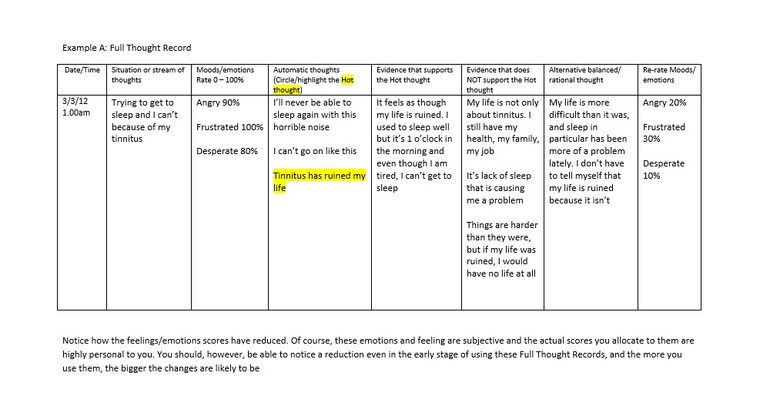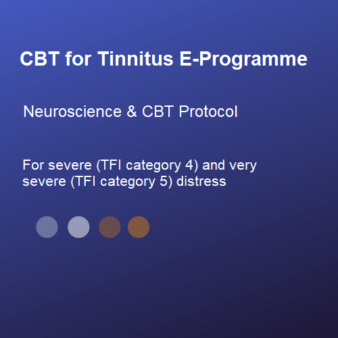ACT, CBT and Neuroscience
Published by Debbie Featherstone in About the CBT for Tinnitus E-Programme · Monday 29 May 2023
I have been updating the CBT for Tinnitus E-Programme Journey section in the website today, and realised I haven't talked in much detail to date about differences between what is commonly referred to as "CBT" and ACT - Acceptance & Commitment Therapy, the best evidence based 3rd wave member of the CBT family of psychotherapies.
Cognitive Behaviour Therapy (CBT) has continued to evolve beyond the traditionally understood framework still commonly practiced and referred to as 2nd wave CBT. Third wave CBT practices, in particular ACT (Acceptance & Commitment Therapy), has built a substantial evidence base since it was first developed by Steven Hayes way back in 1982.
Rather than depend on my own interpretation of the differences between them, I have looked further afield to see what others say about it. I didn't have far to look either! Here's what a popular psychology website PsychCentral says:
"ACT and CBT are similar in that they can help clients break through difficult thoughts and feelings. However, both approach this goal differently: In CBT, you learn to reframe any harmful thought patterns. In ACT, you would learn to accept your situations and negative feelings as a typical part of life." (Psych Central, 2022).
Technically, ACT is a behavioural therapy, whereas traditional 2nd wave CBT is a cognitive therapy.
One of the issues I have found is off-putting for many is the term acceptance itself! It is frequently through misunderstanding what is meant by acceptance that is off-putting: for example, when we think of acceptance as meaning "tolerate", "give in or give up", "put up with", it is no wonder we are put off ACT!
I have many ACT resources from which to draw, and one of my favourites is the work of Russ Harris.
In his book, ACT Made Simple, here is what Russ Harris says about the MEANING of Acceptance and Commitment in ACT:
In ACT, "Acceptance means opening up and making room for unwanted private experiences: thoughts, feelings, emotions, memories, urges, images, impulses, and sensations"; Commitment relates to committed action: "Committed action means taking effective action, guided by our values. This includes both physical action (what we do with our physical body) and psychological action (what we do in our inner world). It’s all well and good to know our values, but it’s only through putting them into action that life becomes rich, full, and meaningful." (Ref: Harris, Russ. ACT Made Simple (The New Harbinger Made Simple Series) (p. 7). New Harbinger Publications. Kindle Edition).
The term CBT is used as an umbrella term for all Cognitive and Behaviour psychotherapies (see Why CBT section), and as the CBT for Tinnitus E-Programme has evolved over time, it is not exclusively either pure 2nd wave CBT or pure ACT. It is true to say though, that since 2018, I moved the focus away from traditional cognitive restructuring of thoughts (2nd wave CBT) where Thought Records are the main restructuring tool:

The Thought Record was the main restructuring tool used in my clinics from when I completed my CBT training in 2005 until 2018, and in the Tinnitus E-Programme, 2009-2018.
Most people did manage to learn how to use it to good effect, but it commonly took several weeks for patients to feel comfortable using the tool. Most often, it would be 2-3 weeks to become confident identifying "Negative Automatic Thoughts" and choosing the Hot Thought, and then invariably another couple of weeks practicing using the full record i.e. Evidence for, Evidence Against, Alternative Thought and Re-rate Emotions, before they could begin to harvest benefit from using the tool. So, I came up with an alternative reframing tool (the Meaning Adjuster). After testing it with patients who had already successfully used the Thought Record who, without exception preferred the Meaning Adjuster to the Thought Record, and testing it with patients who reached the point in their therapy process where they would previously have begun using the Thought Record, the Meaning Adjuster became a permanent replacement of the Thought Record. On average, where using a Thought Record was taking 4 weeks for a patient to START experiencing benefit from using the tool, the average time for a patient to be up and running using the Meaning Adjuster and experiencing benefit was around a week.
The Meaning Adjuster is NOT about changing "thoughts". Rather, it is intended to encourage the user to improve their psychological flexibility, having already begun developing and strengthening a RECOVERY-ORIENTED perspective/mindset, and weakening their old PROBLEM-ORIENTED perspective/mindset.
Adopting a RECOVERY-ORIENTED perspective enables weakening of the fire and wired together neural pathways and patterns of being PROBLEM-ORIENTED.
In debates over issues, problems, difficulties where a solution is being sought, we so often hear the phrase: "this is looking at the PROBLEM, not the SOLUTION"; yet an alternative, and obvious perspective has not yet penetrated the world of tinnitus where the focus persists as being PROBLEM-ORIENTED. While the ideal solution is for tinnitus not to be there at all - I doubt anyone would argue against that - the lack of a cure is viewed as being the problem BECAUSE having a cure is seen as the only solution.
Tinnitus continues to cause significant difficulties for millions of people. Were there to be a "cure" to terminate the noise from being experienced even near the horizon of possibility, there would be no need to seek ways of enabling people to live with tinnitus without it causing them the profound distress that it does for so many. However, because there is no cure on the horizon, in my view what is needed is a reality check: what is the difference between someone who has tinnitus that causes distress and someone who has tinnitus that does not cause distress? Experiencing tinnitus is common to both sets of people.
The difference is that some are distressed and others are not. Commonly, the reason for this is all too often assumed to be loudness of the tinnitus, or the nature of the sound being disagreeable, when in fact, those who have tinnitus but are not distressed by it describe loudness of their tinnitus as variable (sometimes louder, sometimes quieter) or loud, and they are neutral about the nature of the sound.
The difference between the two sets of people is the DISTRESS reaction, hence the efficacy for using Cognitive Behaviour Therapy to bring about a neutral attitude toward tinnitus.
Neuroscience
The more information that emerges from the field of neuroscience, the greater our understanding of why Cognitive Behaviour Therapy (CBT) including Acceptance & Commitment Therapy (ACT) have the profound impact that they have. Relevant neuroscience has been included in the CBT for Tinnitus E-Programme since 2018, and due to ever more understanding over subsequent years, this too has been incorporated in to the programme's process.
It is "firing and wiring together of neurons" in the brain that has the explanation for the triggering reaction (emotion triggering) that hearing tinnitus has for so many: for everyone coming to the CBT for Tinnitus E-Programme, as well as the thousands of patients I've worked with in the past 30 years.
The initial modules in the programme use the latest understandings from Polyvagal Theory neuroscience developments building on what was already understood about the Autonomic Nervous System. These developments continue to transform trauma treatment across the psychology field. and where relevant are informing the content in the CBT for Tinnitus E-Programme.
The protocol used in the new in-depth CBT for Tinnitus E-Programme from July 2020 developed specifically for those with severe and very severe tinnitus distress has gone on to produce consistent Outcomes over time, with more Outcomes due to be published later in 2023.
The programme combines 1-1 support by an experienced dual qualified Psychotherapist & Hearing Therapist via 1-1 appointments, email and interactive tools, with a self-help element. To differentiate it further from other applications and courses claiming to be Cognitive Behaviour Therapy for tinnitus, be they in book or online format, from May 2023 the process used in the programme is defined as a Neuroscience & CBT Protocol.
ACT further reading:
Steven C. Hayes et al (2013) Acceptance and Commitment Therapy and Contextual Behavioral Science: Examining the Progress of a Distinctive Model of Behavioral and Cognitive Therapy, National Library of Medicine: https://www.ncbi.nlm.nih.gov/pmc/articles/PMC3635495/
0
reviews


